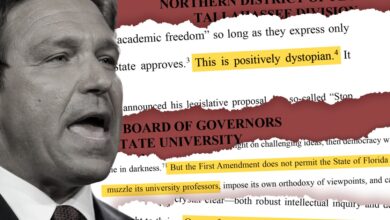3 Takeaways From Supporting Briefs in the Case That Could Change College Admissions

[ad_1]
Only about two months remain before the Supreme Court hears arguments for the most-watched legislative challenge in higher education: two cases that could undo the practice of race-conscious admissions.
The cases were brought by the anti-affirmative action nonprofit Students for Fair Admissions against Harvard College and the University of North Carolina in 2014. They are the most recent attempt by conservative activists and plaintiffs to challenge a precedent that the court has previously upheld.
A decision in these cases could be felt beyond the world of selective admissions. That fact was made clear last week when dozens of groups, ranging from former military leaders, the Biden Administration, large corporations, and many higher-education coalitions filed briefs explaining why Harvard and UNC should be allowed to consider race when admitting applicants. Those briefs followed another set that was filed in May in support of the plaintiffs, arguing that the practice should no longer be allowed. Oral arguments will take place on October 31.
The briefs, known as amici curiae or “friends of the court,” are meant to influence the justices as they decide the cases before them. They are a window into how different organizations, industries, and people think the case at hand applies to them.
Here are three takeaways from the briefs filed in the cases against Harvard and UNC.
Groups supporting the colleges wrote that racial segregation in schools persists — and in some cases is getting worse.
Several leaders of HBCUs filed a brief describing the history of anti-Black discrimination in American higher education. They pointed specifically to Harvard and UNC as colleges that not only barred Black students from entry for most of their existences, but also benefited from the institution of slavery in numerous ways. They argued that these colleges should be able to ensure that the classes they admit are diverse enough that the Black students they admit feel safe and welcomed.
De-facto school segregation still exists today, and in Massachusetts and North Carolina, it has increased in recent years, they wrote.
“Between the 2008-2009 and 2019-2020 school years, intensely segregated non-White Massachusetts schools increased from 143 to 192,” the brief said. “In North Carolina, the number of racially and economically isolated public schools grew by 6 percent between the 2006-2007 and 2016-2017 school years.”
In 2003, a Supreme Court opinion suggested that the then-justices believed that in 25 years, race-conscious admissions will no longer be necessary. The HBCU leaders argued that these facts about Massachusetts and North Carolina show that is not yet the case.
Business and government leaders want colleges to admit diverse classes to help them hire diverse workforces.
A group of southern governors argued that public universities like UNC need to ensure that their admitted classes are diverse because many graduates go on to work in state and local government offices. Those offices must also be diverse and reflect the constituencies they serve, the petitioners argued. Doing so fosters trust in government. Big corporations like LinkedIn, Shell, and Mastercard also said they depend on universities admitting students from diverse backgrounds so those students can go on to work for them.
Some petitioners also worried that a sweeping ruling could have effects beyond selective colleges if the justices agree with some of the petitioners who filed briefs in support of the plaintiffs. As the southern governors put it, “scores of race-neutral programs could be invalidated if a judge detects even a whiff of race-conscious planning, motivation, or impact measurement. Programs across the South designed to ensure equity and access to quality education for all would be thrown into doubt.”
Supporters of SFFA argued that the Supreme Court has an opportunity to correct what they say are past wrongs.
Some petitioners urged the court to overturn Grutter v. Bollinger, the case that upheld colleges’ ability to consider race in admissions. That outcome would have broad implications for many colleges. A large group of Republican senators and congressmen wrote that “Grutter is a constitutional anomaly.” That decision allowed colleges to adopt unfair policies, they argued, and such policies “are untrue to the Constitution’s guarantee of equality under law.”
A group of former staff members of the Department of Education’s Office of Civil Rights, who worked there under the Trump Administration, argued that “the court should embrace the present opportunity to end the pervasive use of race in educational decision-making.” They wrote that successive presidential administrations have “lurched wildly” in their efforts to give colleges guidance on how and whether they can consider race in admissions, and the court must establish a clear rule outlawing the practice altogether.
A brief from the state of Texas, where an earlier case upheld the University of Texas’s consideration of race in admissions in 2016, said that “at best, Grutter has led to confusion. At worst, it has given a thin film of judicial respectability to ‘patently unconstitutional’ practices that ‘amount to outright racial balancing.’” It went further to argue that race-conscious admissions are no longer needed.
Supreme Court justices can consider whichever briefs they want when they write opinions. Sometimes they quote from these briefs, but many go unmentioned.
[ad_2]
Source link






